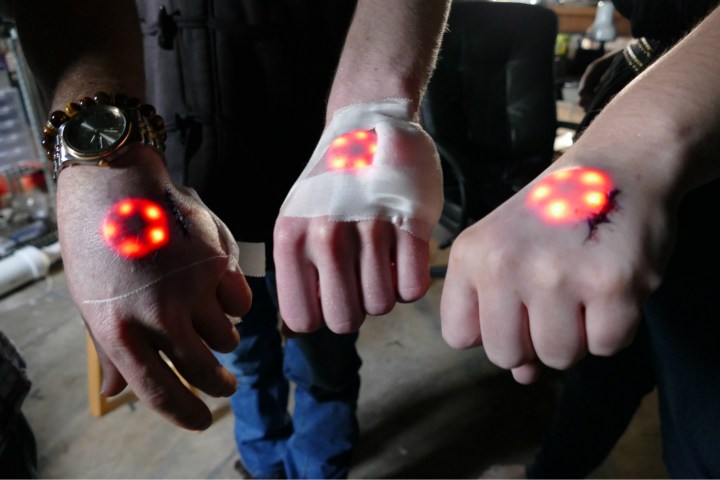
Blood test implant

Researchers at the Swiss Federal Institute of Technology in Lausanne (EPFL) have developed an implantable device they hope to use as a personal blood testing laboratory in the future. The implant uses five sensors, a radio transmitter, and a basic power system. Each sensor is coated with a specific enzyme, allowing the device to monitor substances in the body (namely lactate, glucose, and ATP). The implant is recharged through the patient’s skin via an external battery patch.
Once the blood work has been analyzed, the implant transmits this data to the patch via Bluetooth. This information can then been sent to a doctor over a cellular network for further analysis. The device is still in the prototype phase, though EPFL researchers believe the unit will be commercially available within the next few years. This step toward personalized, at-home medicine could greatly diminish the need for regular check-ups for elderly patients, and individuals with chronic illnesses.
Hearing colors

Artist Neil Harbisson was born with achromatopsia, rendering him completely color-blind. The Human Antenna experiment started as a way for Harbisson to extend his perception of color beyond this limited grey scale. Eventually, Harbisson and his team developed software capable of transposing colors to vibrations using a simple head-mounted camera extension. Initially, Harbisson carried this rather bulky hardware in a backpack, and simply wore a pair of headphones to hear the colors.
Harbisson eventually had this antennae surgically inserted into his occipital bone. The colors he experiences now resound via bone conduction, as the occipital bone reverberates this sensation around his skull. Harbisson was even permitted to wear his headgear in his passport photo. Although Harbisson has certainly enjoyed the advantages of this unique sensory experience, he claims to have never intended to use this as a way to conquer his achromatopsia.
“My aim was never to overcome anything. Seeing in greyscale has many advantages,” said Harbisson in a recent interview with national Geographic. “I have better night vision. I memorize shapes more readily… and black-and-white photocopies are cheaper.”
EyeBorg

The Eyeborg Project is the brainchild of filmmaker Rob Spence. Spence wanted to the ability to deliver a literal point-of-view filming experience. He has accomplished this primary objective by teaming up with ocularist Phil Bowel, who designed the prosthetic camera and electronic eye shell housing. Then, a team of engineers and RF Links, a company that specializes in RF wireless design, created a miniature camera and RF transmitter for the project. This massive collaboration eventually gave us the world’s first literal, POV feed. Next, the team hopes to create an “eyecam” that looks like a real eye rather than a Terminator-esque mockup. If you want to ruin your entire day, you can watch part of the procedure here.
The North Sense

Unlike many of these other implantable biohacks, the North Sense from Cyborg Nest is an “exo-sense” model, meaning the unit is implanted on the surface of the skin. The company suggests attaching the unit specifically to the upper chest. Once there, it has a rather basic purpose. As the name suggests, the device gently vibrates whenever the wearer is facing magnetic north.
Couldn’t this basic functionality be replaced by a compass or rudimentary app? Simply put, yes. However, like the aforementioned Human Antenna project, the whole point is to develop a subliminal relationship with this new stimuli input. At first, this gentle vibration may be slightly jarring, but once you’ve become accustomed to the response, you’ll interpret this data almost subconsciously. Cyborg Nest is currently designing similar technologies pertaining to panoramic audio and visual sensing, which will enable individuals to interpret what is happening behind them at any given time. Read more about the North Sense here.
Biomagnets

Biomagnets are one of the more popular trends in biohacking. This augmentation usually includes either the disc-shaped or bulkier cylindrical magnets, which afford humans alternative ways to interact and sense their environment. As we are all quite familiar, when a magnet encounters a magnetic field, it reacts. Once inserted beneath the skin (ideally along the fingertips or palm), these slight reactions stimulate tactile nerve endings. While the smaller magnets are ideal for tactile sensations, the larger magnets are preferred when it comes to actually lifting and interacting with magnetic objects. You’ll have hours of bar trick capacity literally at your fingertips, however, you might have to be careful to not interfere with your electronic devices.
NFC and RFID tags

RFID and NFC implants are another wildly popular biohack. Most individuals choose to have these implants placed on the back of the hand, directly between the thumb and index finger, or along the wrist. This particular technology is one of the more functional cyborg modifications. Once inserted, these “chips” can be used for a slew of identification purposes, among other functions. These chips can replace many of our keys and passwords, allowing us to use transponders to unlock doors, start vehicles, and even log into computers and smart devices.
Circadia implant

In 2013, Tim Cannon, “cyborg” and Grindhouse Wetware co-founder, infamously had a Circadia 1.0 implanted in his arm without professional medical assistance. The bulky implant protrudes rather conspicuously from the bottom of his forearm. Currently, the Circadia is capable of little more than measuring Tim’s body temperature. However, eventually Cannon hopes more advanced versions of the implant will be able to relay this information to smart appliances, enabling his home to react to his internal temperature. Until that glorious day, we suggest using your run-of-the-mill thermometer, and adjusting your thermostat like the rest of us mere mortals.
Bioluminescence

This project from Grindhouse Wetware adds a whole new meaning to “Day-Glo.” The biohack collective inserted these Northstar V1 implants into a few willing grinders. These units are slimmer than the Circadia 1.0 we previously mentioned, though, they’re about as limited when it comes to functionality. The implants are designed to emulate bioluminescence using a series of LEDs.


